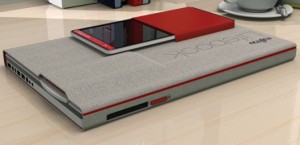Fujitsu will be delivering its latest tablet sometime in the next few weeks, called the Stylistic M532, and it is not targeting the consumer but rather the mobile professional with the lightweight 10-inch device, a move that to a degree sets it apart from most of its rivals.
When you look at the company’s page touting the device the business approach screams out at you. Rather than a full deck of speeds and feeds, which are present, it talks about the tablets ability to support a company’s Virtual Desktop Infrastructure for secure access to apps. It points out how corporate apps such as exchange mail, calendar and contacts can be used safely while remaining behind corporate firewalls.
This is a refreshing approach and it should be helped by the fact that this is not a repositioning of an older machine, it uses Android’s 4.0 (Ice Cream Sandwich) operating system and is powered by an Nvidia quad-core 1.4GHz Tegra 3.
It features a 10.1-inch 1280 x 800 display and has a 2 megapixel front camera as well as a 8 MP backward facing camera. It has 1GB of memory as well as a 32GB flash internal storage drive and supports one MicroSD slot
Many of the players in the tablet space appear to be making headway into the corporate and government space simply via a semi stealth approach. Employees bring in their own devices (BYOD) and rather than set limits or demand uniformity in platforms the BYOD approach appears to be working.
Cisco was one of the first to take a different approach, trying to position its Cius tablet as a business product and selling directly to professionals through its business channel partners. This approach, and possibly its high price point, failed to catch on and now the company is ramping down the product.
According to a piece on ZDNet, Fujitsu is positioning its slightly older Stylistic Q550 offering, a tablet that runs Windows 7, at the BYOD space, enabling it to approach this market from a personal and corporate position at the same time. In addition it looks to have a new lineup in the fall when Microsoft releases Windows 8.
While we do not focus on the corporate segments of the tablet market this strategy is an interesting one since it seems that rather than an all-in-one approach that Apple takes or the specific niche market that the eReaders are developing, Fujitsu is building slightly different products for multiple segments and it will be enlightening to see how they are all accepted or what factors are inhibiting sales.
The benefit for consumers is that if they are looking for a tablet this might be the selling point to get work to pony up the cash and buy it for you, or at least get approval to being it in the office as work approved device.








